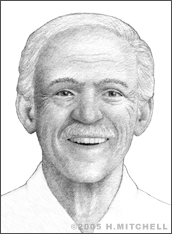Paul Winchell
Paul Winchell was more well known for his show business career than for his accomplishments as an inventor, so it may come as a surprise that it was this ventriloquist and television series character actor, who was the first to design and patent a concept for an implantable, mechanical, artificial heart.
Born Paul Wilchen on December 21, 1922, in New York City, he was a shy boy with a stutter, who conquered his insecurities when he discovered ventriloquism after admiring Edgar Bergen’s performances with his dummy, Charlie McCarthy. Winchell began practicing the art, using his own self-built dummies to entertain classmates and friends. He found he had a real talent, and quickly became quite popular for it.
As a teenager, after winning first place on the radio program “Major Bowes Original Amateur Hour” for a ventriloquism performance in 1936, Winchell jumped onto the vaudeville circuit and began to gain fame around the country. He was invited to host a television program on NBC in 1947 called the "The Paul Winchell-Jerry Mahoney Show" with his dummy, Jerry Mahoney. His biggest break came in 1949 when he appeared on the “Ed Sullivan Show,” after which he was invited to appear on a number of other high-profile TV programs, including "The Lucy Show," "The Dean Martin Show" and "Rowan & Martin's Laugh-In."
He created in 1950 a new dummy named Knucklehead Smiff and introduced him on “The Spiedel Show,” which became “What’s My Name.” He also hosted “The Bigelow Show” and “Circus Time,” followed by his Saturday morning kids’ show, “Winchell Mahoney Time,” gaining legions of fans of all ages in the process. He also performed in dramatic roles in series such as "The Beverly Hillbillies," "Perry Mason" and "Love, American Style," and worked with big-name performers such as Carol Burnett and Angela Lansbury. In 1952 and 1953, Look Magazine had named him “Most Versatile Performer.” In 1954, he published the book "Ventriloquism for Fun and Profit."
In the 1960s, as animation became more popular, Winchell was invited to voice a number of cartoon characters for Hanna Barbera, the Walt Disney Co. and others. His memorable characters include Gargamel from “The Smurfs,” Dick Dastardly from “The Wacky Races” cartoons, Boomer from Disney’s “The Fox and the Hound,” and, most notably, Tigger from the “Winnie the Pooh” series. He voiced Tigger in Disney’s 1968, Oscar-winning animated feature “Winnie the Pooh and the Blustery Day," and won a Grammy Award for his recording of the song “The Most Wonderful Things About Tiggers" from the feature "Winnie the Pooh and Tigger Too." He credited his then-wife with coming up with Tigger's signature phrase "TTFN," or "Ta-ta for now."
Meanwhile, however, Winchell, though lacking in formal education, was passionate about a variety of subjects unrelated to the entertainment world, especially medicine and hypnosis. In 1959 he enrolled at Columbia University and finished his studies in 1974 when he became a Doctor of Acupuncture after graduating from The Acupuncture Research College of Los Angeles. For a time he worked at the Gibbs Institute in Hollywood as a medical hypnotist.
In the 1950s his acceptance of an invitation to appear on the "Arthur Murray Dance Party" Show would change his life in some respects: Competing on the show against none other than Ricardo Montalban, Winchell won a dance-off (and a brand new Buick automobile). At a subsequent cast party, he met Dr. Henry Heimlich, the inventor of the Heimlich maneuver, and the two developed a lifelong friendship. After Heimlich invited Winchell to observe surgery in his operating room on several occasions, Winchell had the idea to create an artificial heart that he thought could help keep blood pumping through a difficult open-heart surgery procedure so that a patient might have a better chance of getting through it in dire circumstances. With the help and advice of Heimlich, Winchell designed an artificial heart and built a prototype. He filed for a patent in 1956, which he received in 1963.
Later, when a team of researchers lead by Dr. Robert Jarvik began developing an artificial heart concept at the University of Utah, Winchell donated his patent to the institution and Jarvik, using many of Winchell’s basic principles, took the device further, culminating with the Jarvik-7, the first artificial heart model to be successfully implanted in a human being, Barney Clark, in 1982.
Winchell, in fact, invented a number of devices, receiving a total of 30 patents in his lifetime, for products ranging from a disposable razor, to a flameless cigarette lighter, portable blood plasma defroster, invisible garter belt, retractable fountain pen and battery-heated gloves. He also owned a shirt factory and proposed an idea he called “The Tilapia Project,” which would have used the production of rapidly reproducing tilapia fish to help feed starving people in under-developed nations.
Winchell, who won a nearly $18 million verdict in 1986 when Metromedia was found to have destroyed the only remaining tapes of his work on the “Winchell Mahoney Time” show in a dispute over syndication rights, published his autobiography, “Winch,” in 2004. He donated his dummies Jerry Mahoney and Knucklehead Smiff, to the Smithsonian Institution. He continued to innovate, write, and occasionally perform until he died on June 24, 2005, at the age of 82.


